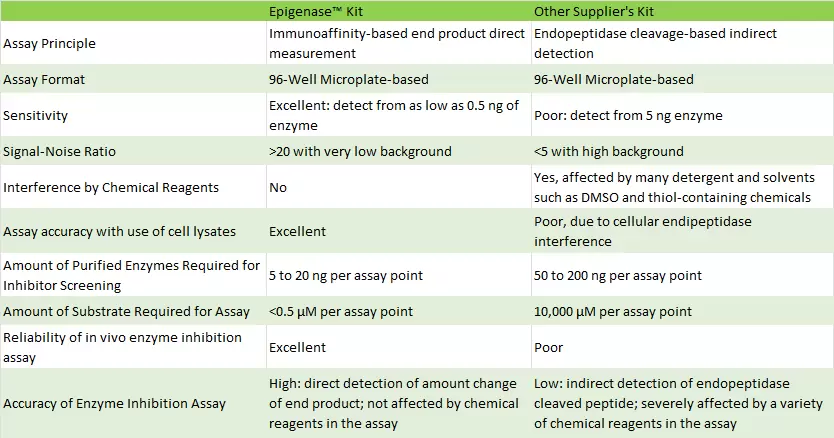Epigenase HDAC Activity/Inhibition Direct Assay Kit (Fluorometric)
Product Description
The Epigenase™ HDAC Activity/Inhibition Direct Assay Kit is a complete set of optimized buffers and reagents for fluorometrically measuring the activity or inhibition of total HDAC enzymes in nuclear extracts or purified HDAC isoforms (HDACs 1-11) from a broad range of species such as mammalians, plants, fungi, and bacteria, and in a variety of forms including, but not limited to, cultured cells and fresh and frozen tissues. The Epigenase™ HDAC Activity/Inhibition Direct Assay Kit is a further refinement of its predecessor, the EpiQuik™ HDAC Activity/Inhibition Assay Kit, a popular assay method for HDAC activity and inhibition. This latest method retains the simplicity, rapidness, high throughput capability, and non-radioactivity featured in the previous version, while offering the following advantages:
- Improved kit composition enables background signals to be very low, which allows the assay to be more accurate, sensitive, reliable, and consistent.
- Innovative fluorometric assay measures HDAC activity/inhibition by directly detecting HDAC-converted deacetylated products, rather than trypsin-based peptide cleavage, thus eliminating assay interference caused by DMSO, thiol-containing chemicals, trypsin, and cellular lysyl endipeptidases.
- Both cell/tissue extracts and purified HDAC enzyme can be used, which allows for the detection of inhibitory effects of HDAC inhibitor in vivo andin vitro.
- Novel assay principle allows high sensitivity to be achieved. The activity can be detected from as low as 0.5 ng of purified HDAC enzyme, which is about 10 fold higher than that obtained by trypsin-based peptide cleavage assays.
- A deacetylated histone standard is included, which allows the specific activity of HDACs to be quantified.
- Trichostatin A (TSA), a potent inhibitor of class I and class II HDAC activity, is included as the positive control for the HDAC inhibition.
- Strip-well microplate format makes the assay flexible and quick: manual or high throughput analysis can be completed within 3.5 hours.
Background Information
Acetylation of epsilon amino group of specific lysine residue contained in core histones is one of the most robust epigenetic marks and is essential for the regulation of multiple cellular processes. The acetylation of histone by histone acetyltransferases (HAT) seems to be of particular significance, as it is associated with active regions of the genome. In contrast, histone deacetylation by histone deacetylases (HDAC) leads to transcription repression. So far, at least 4 classes of HDACs have been identified. Class I HDACs include 1, 2, 3 and 8. Class II HDACs are comprised of 4, 5, 6, 7, 9 and 10. Class III enzymes, known as the sirtuins, require NAD+ cofactors and include SIRTs 1 through 7. Class IV enzymes, which contains only HDAC11, have features of both Class I and II.
HDACs are tightly involved in cell cycle regulation, cell proliferation, and development of human diseases including cancer, cardiovascular and pulmonary diseases, and neurological diseases. For example, in various tumor cells, HDAC enzymes are found to be overexpressed. In chronic obstructive pulmonary disease (COPD) HDACs are observed to be decreased. In Huntington’s disease, HDAC4 is critically involved. Detection of activity and inhibition of HDACs would be important in elucidating mechanisms of epigenetic regulation of gene activation and silencing and would benefit cancer diagnostics and therapeutics.
Principle & Procedure
The Epigenase™ HDAC Activity/Inhibition Assay Kit contains all reagents necessary for the measurement of HDAC activity/inhibition. In this assay, an acetylated histone HDAC substrate is stably coated onto the microplate wells. Active HDACs bind to the substrate and removes acetyl groups from the substrate. The HDAC-deacetylated products can be recognized with a specific antibody. The ratio or amount of deacetylated products, which is proportional to the enzyme activity, can then be fluorometrically measured by reading the fluorescence in a fluorescent microplate reader at 530ex/590em nm. The activity of the HDAC enzyme is proportional to the OD intensity measured.

Product Citations
- Xu Q, Wang Y, Chen Z, Yue Y, Huang H, Wu B, Liu Y, Zhou DX, Zhao Y (2022) ROS-stimulated protein lysine acetylation is required for crown root development in rice. J Adv Res
- Ageeva-Kieferle A, Georgii E, Winkler B, Ghirardo A, Albert A, Hüther P, Mengel A, Becker C, Schnitzler JP, Durner J, Lindermayr C (2021) Nitric oxide coordinates growth, development, and stress response via histone modification and gene expression. Plant Physiol
- Ageeva-Kieferle, A et. al. (2020) Nitric oxide coordinates histone acetylation and expression of genes involved in growth/development and stress response bioRxiv
- Roy G, Brar HK, Muthuswami R, Madhubala R (2020) Epigenetic regulation of defense genes by histone deacetylase1 in human cell line-derived macrophages promotes intracellular survival of Leishmania donovani. PLoS Negl Trop Dis
- Zheng Y, Ge J, Bao C, Chang W, Liu J, Shao J, Liu X, Su L, Pan L, Zhou DX (2020) Histone Deacetylase HDA9 and WRKY53 Transcription Factor Are Mutual Antagonists in Regulation of Plant Stress Response. Mol Plant
- Catalog Number
P-4035-96-EP - Supplier
EpigenTek - Size
- Shipping
Blue Ice

